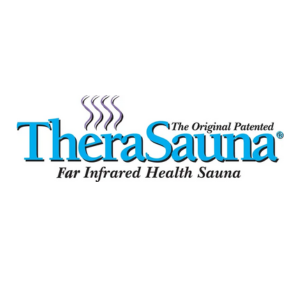SAUNA GUIDELINES:
WHAT TO KNOW BEFORE YOU SWEAT
Once deemed a passing health trend, saunas have officially gone mainstream in recent years, and all for the right reasons too. From reducing stress and improving sleep quality to boosting your immune system, saunas offer many health benefits.
Sure, saunas aren't a one-stop solution to all your health woes, but if you struggle with issues like insomnia, poor immunity, and stress, regular sauna sessions can go a long way in helping with your health issues.
Before you put on a robe and jump into a sauna bath, it's important to understand the proper sauna guidelines to make the most of your experience.
Read on to learn about the various aspects of a sauna bath, including potential risks, hygiene practices, safety precautions, and post-sauna care.
Sauna Guidelines: Precautions for Safety
Follow these sauna guidelines like a pro and maximize sauna health benefits.
Consult a Healthcare Professional
f you suffer from chronic health conditions, consult a healthcare professional before incorporating sauna sessions into your self-care routine.
Research shows that certain medical conditions, including coronary artery disease, compromised immune system, diabetes, or neurological deficit, may increase your risk of heat stroke.
It's also vital to ask for your doctor's clearance if you've had a medical device implanted, such as an artificial heart valve. Additionally, if you're pregnant, it's best to err on the side of caution and avoid sauna sessions altogether.
Dress Appropriately
When dressing for a sauna bath, the general rule is to wear as little clothing as possible. Opt for loose, breathable clothing or swimwear made from natural fibers such as cotton or linen.
The Department of Industrial Relations California notes that such fabrics allow your skin to breathe and prevent moisture buildup, reducing the risk of heat exhaustion (fatigue and weakness resulting from prolonged exposure to heat).
Steer clear of synthetic materials, which can trap heat and make it difficult to cool down. It's also important to wear a bathing cap or towel on your head to help absorb extra sweat and prevent it from dripping down onto your face.

Stay Adequately Hydrated
While sweating in a sauna can be incredible for eliminating toxins from your body, the process can also affect your mineral balance and fluid levels. The Cleveland Clinic notes that excessive sweating can lead to dehydration, electrolyte imbalances, muscle cramps, weakness, and other health complications if not properly managed.
To help avoid this, drink plenty of water before, during, and after your sweat session. It is also good to consume electrolyte-rich beverages and food, including sports drinks, coconut water, or bananas, to replenish the fluids lost through sweating.
Alcohol has also been shown to interfere with your body's ability to regulate temperature, so you want to avoid drinking it before a sauna bath.
Take a Light Meal or Snacks
Your core body temperature increases during a sauna session, resulting in profound sweating and a higher metabolic rate. This increased metabolic activity requires energy, primarily from the food you take, per the Molecular Biology of the Cell.
Enter a sauna on an empty stomach. Your body might not have enough energy to sustain this increased metabolic activity, potentially leading to fatigue, weakness, and an uncomfortable experience.
Consider taking easily digestible foods with a high nutrient and water content around two hours before your sauna session. This will help maintain your energy levels and help stabilize your blood sugar throughout the session.
Avoid heavy, greasy, or spicy meals, as they may be difficult to digest, which can lead to bloating and nausea.

Adjust Temperature
Our heat tolerance levels can vary significantly, so you must find one you feel comfortable with. Most infrared saunas operate at 120 to 130 degrees Fahrenheit, but some traditional models can reach up to 190 degrees.
According to My Health Alberta, when the body is exposed to excessive heat, blood vessels expand, which can cause your body fluid to move into your legs by gravity. This can make you feel lightheaded or dizzy, especially if you're not used to being in high temperatures.
Remember that the higher temperature means you'll also sweat more, which can result in increased fluid and mineral loss. Ideally, you should start at a low sauna temperature and the work your way up as your body acclimates to the heat.
Another important safety tip for beginners is to avoid staying in the sauna for more than 20 minutes at a time. If you feel comfortable, you can gradually increase the duration by five minutes and keep doing so until you reach a maximum of 45 minutes.
Listen to Your Body
Individual tolerance for heat and humidity can vary based on age, fitness level, and pre-existing medical conditions, which can influence how your body responds to a sauna session.
If you experience any discomfort, dizziness, nausea, or rapid heartbeat at any point, exit the sauna immediately and allow your body to cool down.
When transitioning from a heated environment to a cooler one, your blood pressure may drop, causing your heart to beat faster. This is a normal response that should subside within a few minutes.
Sauna Guidelines: Maintaining Hygiene in the Sauna
Maintaining proper hygiene during a sauna session is important because saunas are warm and humid environments that can be potential breeding grounds for bacteria and germs. Here are a few ways proper hygiene can help prevent the spread of germs and infections:
-
Taking a shower before a sauna session is recommended to remove any dirt, sweat, or body oils. This can help keep your sauna clean and prevent the spread of bacteria.
-
Always place a clean towel on the sauna bench before sitting or lying down. This can help prevent direct contact between your skin and the bench, reducing the risk of burns and infections.
-
Since you'll sweat profusely in a sauna, keeping two clean towels by your side is important. This way, you won't have to worry about sweat dripping onto the sauna floor.
-
When using a public sauna, avoid touching your face to prevent the spread of acne-causing bacteria.
-
If you have a cold, flu, or other contagious illness, avoid using the sauna until you fully recover. This can help prevent the spread of germs and keep the sauna environment healthy for others.
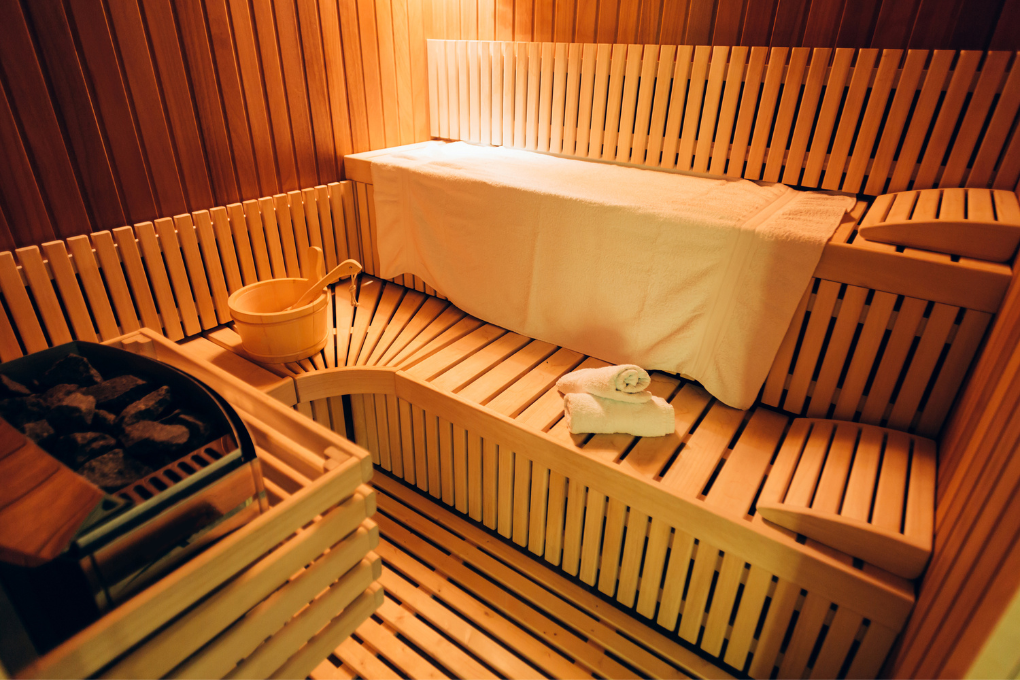
Sauna Guidelines: Children and Sauna Use
Saunas can be a wonderful way to introduce your child to a healthy and relaxing lifestyle that can benefit them for years. Following these tips and guidelines ensures your child has a safe and enjoyable sauna experience they will cherish and remember:
-
Check with your doctor before taking your child to a sauna, especially if they have any medical conditions or are taking any medications that may affect their ability to tolerate heat or sweat.
-
You can take kids of any age to a sauna session. Still, experts recommend avoiding taking children under the age of seven to a sauna, as they may not be able to regulate their body temperature well and may be more prone to overheating and dehydration.
-
Choose an infrared sauna over a traditional one, as it provides a different type of heat that may be more comfortable and beneficial for children. Infrared saunas (such as the MX-K206-01 Maxxus Canadian Hemlock) use light waves to heat the body directly rather than heating the air around it.
-
Start slow with your child, and gradually increase the time and temperature of the sauna sessions. Experts recommend no more than 15 minutes per session and an hour in total. The temperature should be low enough that your child is not sweating excessively or feeling uncomfortable.
-
Monitor your child closely during and after the sauna, and look for any signs of discomfort, such as nausea, dizziness, headache, hot flashes, cold chills, or irregular heartbeat. If your child experiences these symptoms, leave the sauna immediately and cool down slowly. Rehydrate and seek medical attention if needed.
-
Make it fun and memorable for your child by creating some sauna traditions and rituals they can look forward to. For instance, you can choose a special drink only available when going to the sauna or make some pampering treatments with natural ingredients, such as a foot bath or a foam massage. You can also play some games, tell some stories in the sauna, or race to the water if you can access a lake or pool for a cold plunge.
-
Teach your child respect and etiquette for using the sauna, especially when sharing it with others. Explain the importance of keeping the sauna clean and hygienic by bringing a towel to sit on and cover yourself with and not leaving any litter behind. Also, teach them to be quiet and polite in the sauna and not to disturb or annoy other users.
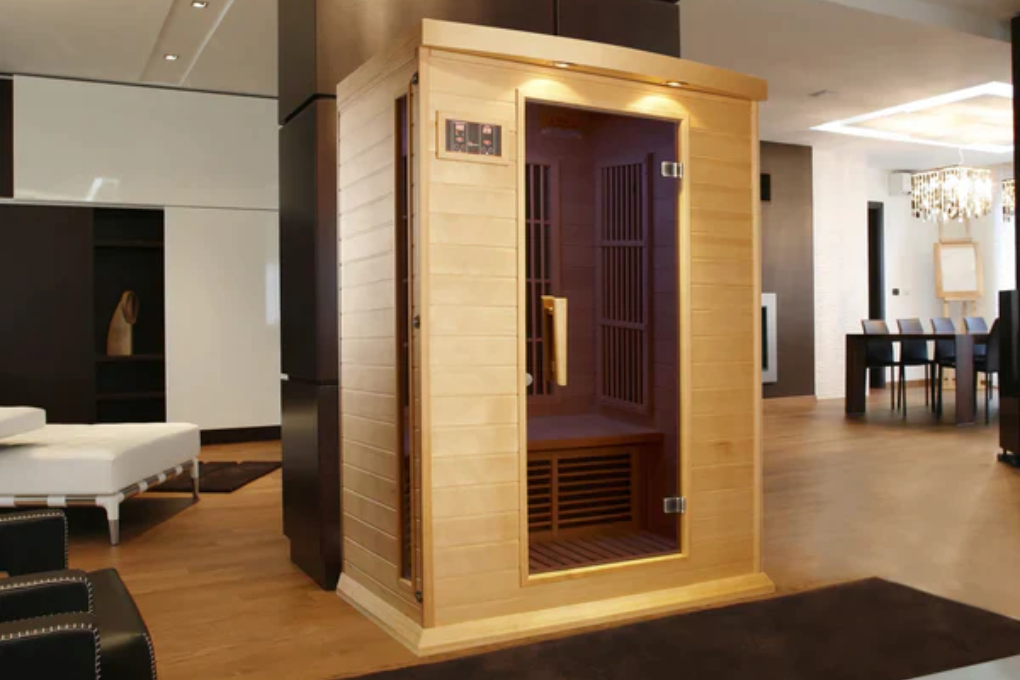
Sauna Guidelines: What To Do After a Sauna Session
Once your sauna session ends, it's important to follow a few additional steps to help your body recover and maximize the benefits of your sauna therapy:
-
Consider sitting or standing in a cooler area for a few minutes after a sauna bath. This will allow your body temperature to normalize and help prevent dizziness or lightheadedness.
-
Once you cool down, shower or plunge into a cold pool if possible. This can help tighten your pores and improve circulation. Studies show that alternating between hot and cold therapy can help expedite muscle recovery, boost your immune system, and help with chronic pain.
-
Sweating in a sauna can be incredibly dehydrating, so drink plenty of water or electrolyte-rich beverages afterward.
-
If you're using a dry sauna for more than 15 minutes, moisturize afterward to help replenish your skin.
Sauna Guidelines: Sauna Maintenance and Safety Measures
Regular sauna maintenance and inspections are important to ensure the sauna works properly and safely. Here are a few tips for maintenance and safety measures:
-
After every sweat session, vacuum the floor and clean all surfaces, including benches, floors, and handles, using mild detergent to eliminate excess moisture. Avoid harsh chemicals that can damage the wood or emit toxic fumes when heated.
-
Ensure proper ventilation and air circulation to speed up the drying process. This can also help maintain humidity levels and prevent mold and mildew growth.
-
Regularly inspect the sauna heater for any signs of damage, wear, or malfunction. This includes checking the heating elements, vents, and electrical connections. If there are any issues, consult a professional for repairs or replacements.
-
Sauna stones can become cracked or disintegrated over time. Ensure to frequently inspect the stones and replace them as needed to ensure efficient heat distribution and prevent potential damage to the heater. Also, try covering them with a plastic tarp to prevent grit accumulation.
-
When using a wood-burning sauna (such as the Dundalk Leisure Sauna), consider regularly treating the surfaces with specialized products to protect the wood from any potential damage due to moisture and stains.
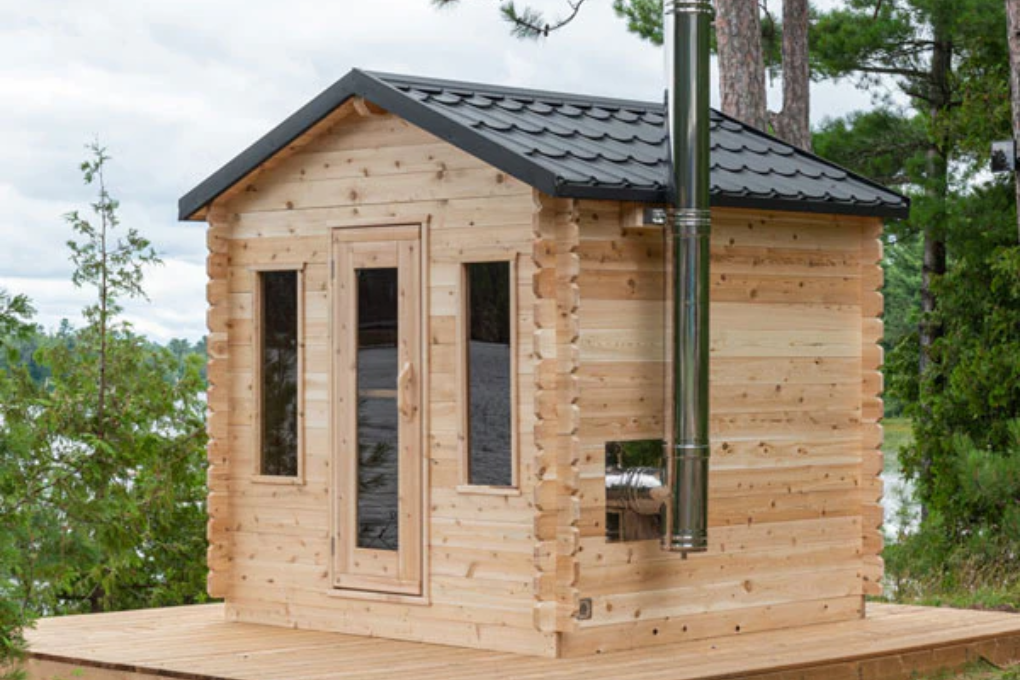
Sauna Guidelines: The Takeaway
While saunas are a great way to relax and enjoy various health benefits, such as relieving pain, reducing stress, and improving sleep quality, they also come with risks. Hence, it's important to exercise caution when using them.
From staying hydrated and ensuring the sauna is properly ventilated to consulting a doctor if you have any medical conditions, there are several precautions you should take before and during your sauna sessions to have a safe and enjoyable experience.
If you want to try sauna therapy at home, check out MySaunaWorld's collection of traditional and infrared saunas. For more information or queries, feel free to contact us; our friendly staff will gladly assist you.
SIGN UP. SAVE BIG.
Subscribe to be the first to know about our special monthly sauna sales, sent right to your inbox.

About the Author
Adam Fromson
Adam Fromson, co-founder of My Sauna World, loves saunas and their transformative health benefits. With years of experience exploring sauna culture and its impact on health and wellness, Adam is passionate about helping others discover the life-changing benefits of saunas for themselves.
Let customers speak for us
from 385 reviews
Good communication, easy delivery, easy set up, easy operation, great value. Recommended!
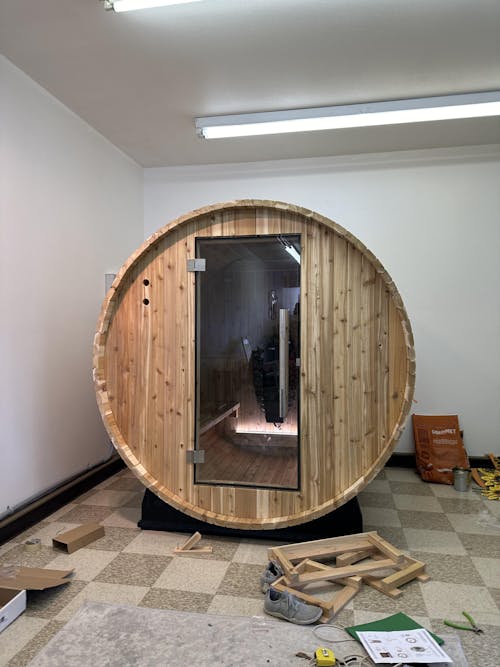
We ordered the 4 person barrel sauna and love it! We wanted a little extra space for the 2 of us/guests and it’s great. We could definitely fit 4 people in it if we needed. We use it every single day. It took about 10 weeks to get here because they build it specifically for the order. Putting the barrel together was fairly easy with 2 people. The electrical and the heater definitely required an electrician to install as we could have not done it alone.
We ordered the biggest heater (harvia spirit 8kw) and it heats up the sauna in about 15 mins inside our 40-50° garage. Overall this style of sauna is hotter and you sweat a lot faster than in an infrared sauna. I truly 10/10 recommend!
Pic is of us in the middle of building it.
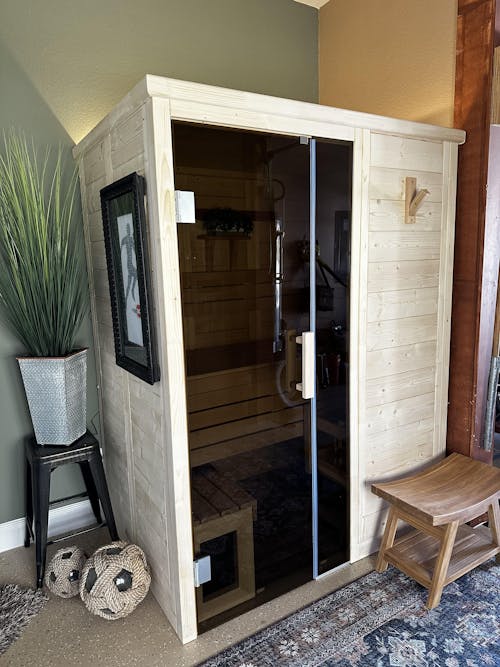
Took me about 6 hours over 2 evenings to assemble almost all by myself. Had a pro run a new circuit from my panel. Very well made and assembly was straightforward. Heater is well sized and reaches operating temperature in under 30 minutes.

Great sauna very easy to assemble

The salt panel was a great addition to our Madison Sauna. It has excellent grain which is accented by the amazing color lights that glow through the panel. Also when you hit the rocks with a splash of water you can feel the heat bounce off the panel. Great addition if you are considering this option.
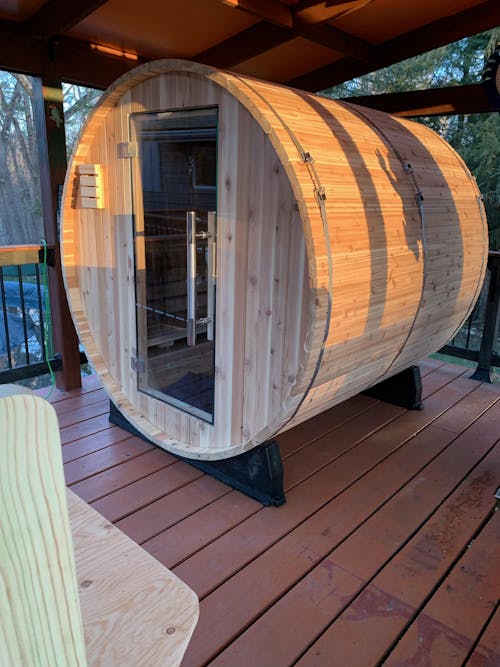
We can say enough about Sauna World there customer support is great! Our Pinnacle Sauna from Almost Heaven is epic.
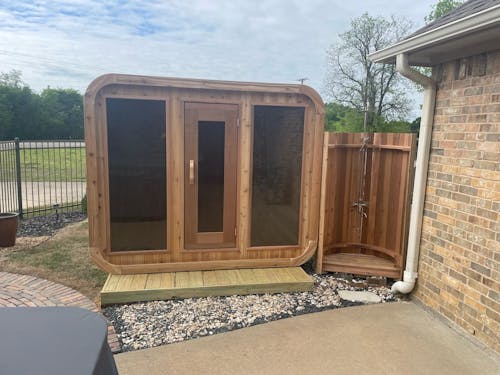
The finish and quality is outstanding and it was quick and easy to assemble.

We are thrilled with our mini pod!! It came well shipped and our friend assembled it in 11 hours! Wow! We cannot wait to get healthy and sauna it up!

Beautiful sauna!!! Much easier than I expected to assemble, took a total of 4 hours. Can't wait to get warm by the pool on those cool evenings. Customer service was excellent..

Purchased a 2 person Almost Heaven barrel sauna and were delighted with the product. The order process was quick and easy, the sauna arrived on-time, installation was simple, following the provided instructions, and the sauna is extremely high quality. We’ve used it daily for over 2 weeks and quite frankly I don’t know how we lived without it. If I had it to do over again I wouldn’t change a thing... except maybe purchasing a 4 person model to easier share with friends!

Great Customer Service and a breeze to put together.Excellent shipping and the Sauna is top notch, couldn’t be happier




























